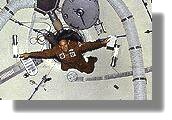|
I'm sure you've seen astronauts in the Shuttle, on T.V., and marvelled at how they seem to float around,... almost as if there were no gravity! Have you ever wondered about the things they never show on TV... like, what happens if somebody throws up? How do they go to the bathroom?? Believe it or not, these are actually important questions; they pose problems that scientists have been working on for a long time. Before we show you their answers, we need to clear up a very common misunderstanding. When an astronaut in orbit is seen to be floating around his spacecraft, he is indeed 'weightless', if you mean by this, 'He would weigh nothing if he were standing on a bathroom scale'. But it is wrong to say that the force of gravity on him is zero, or that 'there is no gravity'. Gravity is still there, and it's just about as strong as it is on the surface of the Earth. He is 'weightless' the same way you would 'weigh nothing' if you jumped out of an airplane and were falling freely toward the ground. If a bathroom scale was falling freely beside you, and you tried to stand on it, it would register your weight as zero, because it's falling too. But both you and the scale are still under the pull of the earth's gravity. The force of gravity isn't zero, just the weight In the space shuttle, both the shuttle and the astronauts were falling freely around the earth. That's what an 'orbit' is. Imagine you were inside a big box that someone pitched out of an airplane. You would be floating around inside the box as you and it fell together. Rather than saying the astronauts are 'weightless', it makes more sense to say they are 'continuously falling'... from a height so great that the earth 'curves out of the way' underneath them, so they never hit the ground! The force of gravity at their height above the earth is only slightly less than it is right here on the surface! Actors (including Tom Hanks) in the movie 'Apollo Thirteen' underwent this procedure in order to film the 'weightless' scenes in the movie. The actors ended up having more time 'weightless' than many former astronauts in space ever did! Astronauts often get sick the first time they experience 'weightlessness'. Some always get sick. This can be very unpleasant in the close confines of a spacecraft, since everything floats around, including the vomit! It tends to congeal into large spherical globules that float around the cabin with the air currents. Aside from the unpleasantness of breathing in the stuff, or having it float onto your sandwich, astronauts also have to prevent it from gumming up or shorting out the equipment. The mess is very quickly cleaned up with a vacuum cleaner... which is perfect for sucking errant bits of stuff out of the air! A liquid that the astronauts want to drink, water for instance, can be slid out of its container, where it will hang in the air in a big 'blob'. It can be sucked up with a straw inserted into the 'blob' of water! But to prevent water droplets from shorting out the equipmant, astronauts drink from plastic bulbs with an attached straw. Just like the kind your baby sister uses!  After consuming a certain amount of liquids or solid food, all astronauts will sooner or later have to visit the bathroom.
This presents certain problems in space, as the liquid or solid waste doesn't 'fall', it just floats! (Actually, of course, it's falling with you around the earth). The earliest spacecraft allowed occupants almost no room to move around; the 'toilet' consisted of, for men, a vacuum tube that you plugged into in front, and a big bag with sticky tape around the mouth that you stuck on behind (so to speak). The arrangements were similar for women, except that the one in front went inside (and was described by many female astronauts as an 'instrument of torture'). After consuming a certain amount of liquids or solid food, all astronauts will sooner or later have to visit the bathroom.
This presents certain problems in space, as the liquid or solid waste doesn't 'fall', it just floats! (Actually, of course, it's falling with you around the earth). The earliest spacecraft allowed occupants almost no room to move around; the 'toilet' consisted of, for men, a vacuum tube that you plugged into in front, and a big bag with sticky tape around the mouth that you stuck on behind (so to speak). The arrangements were similar for women, except that the one in front went inside (and was described by many female astronauts as an 'instrument of torture'). The Shuttle's facilities were a little more up-to-date... but not much. Essentially the urine collection was done the same way, except that you could go to the tube (you didn't wear it). Solid waste was collected by something that acted much like a real toilet, except the waste and flushed water were vacuumed away. It did plug up occasionally. Facilities on the International Space Station are similar. Probably the first real toilet will have to await the construction of a large, rotating space facility, where rotation causes a centripetal force that simulates gravity. Imagine a tiny 'you' standing on the bottom of a bucket that someone is swinging around their head. You would feel 'heavy' in the direction of the bottom of the bucket. Amusement park ride builders know this. Such rotating 'space stations' might supply a sort of 'gravity' for your toilet... but then you'd have the problem of Coriolis forces... |